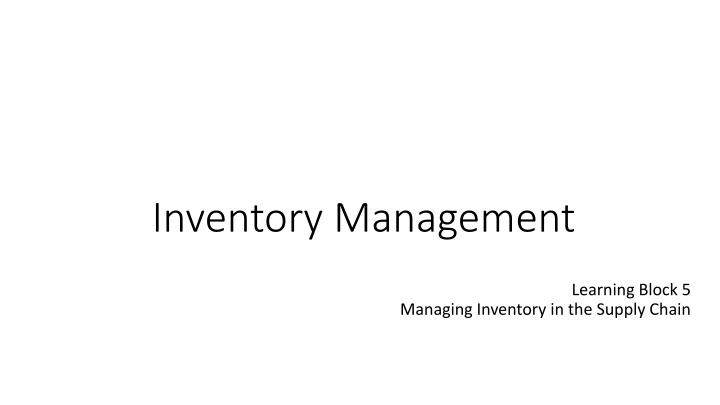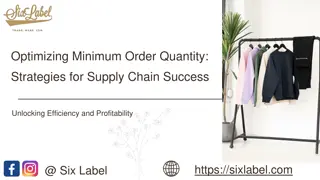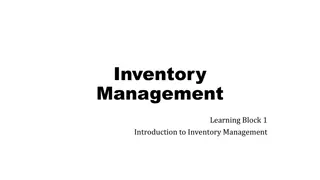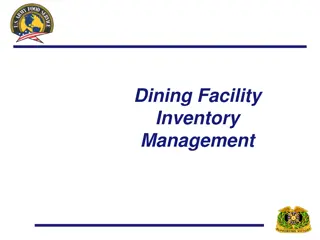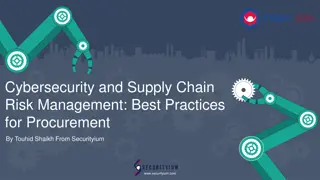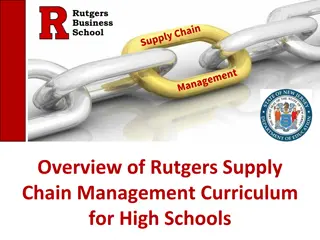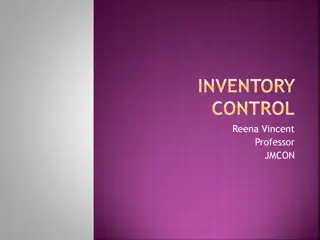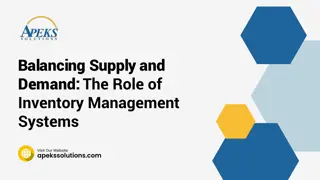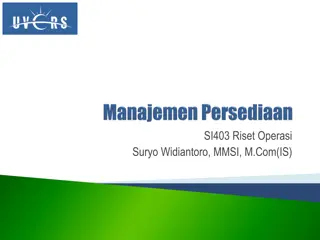Managing Inventory in the Supply Chain: Tools, Techniques, and Strategies
This learning block delves into the crucial aspects of managing inventory in the supply chain, addressing demand variability, the bullwhip effect, and the role of third-party systems. Learners will explore the significance of inventory in supply chains, discuss tools for effective inventory management, and consider outsourcing options for inventory activities. The unit emphasizes the balance between supply and demand in various chain locations to optimize operations and address uncertainties.
Download Presentation

Please find below an Image/Link to download the presentation.
The content on the website is provided AS IS for your information and personal use only. It may not be sold, licensed, or shared on other websites without obtaining consent from the author.If you encounter any issues during the download, it is possible that the publisher has removed the file from their server.
You are allowed to download the files provided on this website for personal or commercial use, subject to the condition that they are used lawfully. All files are the property of their respective owners.
The content on the website is provided AS IS for your information and personal use only. It may not be sold, licensed, or shared on other websites without obtaining consent from the author.
E N D
Presentation Transcript
Inventory Management Learning Block 5 Managing Inventory in the Supply Chain
Course Agenda 1. Introduction to Inventory Management 2. Monitoring and Analyzing Inventory 3. Inventory Control 4. Inventory Management and Forecasting 5. Managing Inventory in the Supply Chain 6. Inventory Performance Measurement and Financial Implications 2
Managing inventory in the supply chain Learning Block 4
Learning Block Agenda Inventory and the Supply Chain The Bullwhip Effect Collaborative Planning, Forecasting, and Replenishment (CPFR) Managing Inventory Flows in the Supply Chain Third Party Systems
Description This learning block addresses key tools and techniques and third-party-based systems for managing inventory in the supply chain. It also outlines how demand variability throughout the supply chain can lead to over- or under- stocking of inventory at different points in the chain. 5
Learning Objectives Upon completing this learning block, the learner will be able to: Discuss the role and importance of inventory in the supply chain Understand how demand variability throughout the supply chain can lead to over- or under-stocking of inventory (also known as the bullwhip effect) Describe tools and techniques used for managing inventory in the supply chain Discuss options for outsourcing inventory management activities, entirely or in part, to a third party
Unit 1: Inventory and the Supply Chain The central purpose of inventory in supply chains is to achieve the best possible balance of the supply and demand of goods. To manage the flow of goods through the supply chain effectively, companies have to deal with sources of supply and customer demands. Companies must try to balance meeting customer demands, which are not always easy to accurately forecast, with both stocking and ordering a sufficient supply of materials and goods. Holding inventory at various points in the supply chain helps balance supply and demand and buffer against uncertainty. These points include retail stores, wholesaler locations, distributor locations, manufacturer locations, and raw material provider locations.
The Impact of Not Managing Inventory Failing to manage inventory well across the supply chain could have a detrimental effect on company performance. Inventory mismanagement can impact many of the areas in the supply chain with the following results: Purchasing, Manufacturing, Inventory, Warehousing, Transportation, Customer Service
Unit 2: The Bullwhip Effect Variations in one part of the supply chain is compounded in other parts of the chain as each function overestimates or underestimates demand, resulting in exaggerated fluctuations and leading to over- or under-stocking of inventory.
Unit 3: Collaborative Planning, Forecasting, and Replenishment (CPFR) Collaborative planning, forecasting, and replenishment (CPFR) is one way to reduce uncertainty by ensuring that supply chain functions develop common forecasts for individual SKUs to reduce uncertainty, decrease inventory levels, and improve customer service. Companies cooperate using CPFR to manage inventory, provide inventory visibility, and order and replenish product throughout the supply chain.
Unit 4: Managing Inventory Flows in the Supply Chain Push vs. Pull Systems Inventory Postponement Just-in-time (JIT) Systems Vendor-Managed Inventory (VMI)
Push vs. Pull Systems The pull approach relies on customer demand to pull product through the supply chain. In contrast, the push or proactive approach uses inventory replenishment to anticipate future demand.
Postponement Postponement is an inventory management tool in which products are manufactured to a semi- finished state and then finished to meet individual customer orders. It is often more cost-effective to hold semi- finished inventory rather than trying to anticipate and build every final product configuration different customers might demand.
Just-in-Time (JIT) Just-in-time (JIT) delivery is a method for supplying products using a strategy of shipping in smaller, more frequent lots with deliveries that arrive as they are needed rather than requiring the stockpiling of materials or parts. Benefits of a JIT delivery system include the following: Minimized handling of materials Reduced inventory and space requirements Imposed quality discipline Reduced total production costs Reduced product cycle time (i.e., the time required to get products to the marketplace)
Unit 3: Collaborative Planning, Forecasting, and Replenishment (CPFR) Collaborative planning, forecasting, and replenishment (CPFR) is one way to reduce uncertainty by ensuring that supply chain functions develop common forecasts for individual SKUs to reduce uncertainty, decrease inventory levels, and improve customer service. Companies cooperate using CPFR to manage inventory, provide inventory visibility, and order and replenish product throughout the supply chain.
Third-Party Systems A third-party logistics firm (3PL) is an external supplier that performs all or part of a company s functions. Third parties can include suppliers of services such as transportation, warehousing, distribution, financial services, marketing services, and manufacturing services. Inventory management can also be handled by an outside firm. Supplier-Managed Inventory (SMI) Consignment Stocking
Third Party Inventory Management Supplier-Managed Inventory (SMI) is a supply chain model in which the supplier has the responsibility for maintaining the purchaser s inventory levels. Consignment Stocking a supplier provides products to a buyer that are stored at the buyer s facilities, but the inventory is still owned by the supplier. The buyer assumes responsibility for the stock when stock is withdrawn from that consignment inventory, pays for the quantity used, and notifies the supplier of the need to replenish inventory.
Summary A supply chain encompasses several participants who move physical goods anywhere from the point of origin to the point of final consumption. Thus, inventory plays a very important role in supply chains. Much of the activity involved in managing supply chains is based on the purchase, transfer, or management of inventory. The most basic role that inventory plays in supply chains is balancing the demand and supply of goods. Supply chain factors like order placement timing, demand and supply variations, and lack of communication and disorganization can result in an effect known as the bullwhip effect. CPFR can help to avoid this by helping supply chain members develop a common forecast for individual SKUs to reduce uncertainty, decrease inventory levels, and improve customer service. Specific approaches include pull vs. push systems, consignment stocking, postponement, JIT delivery, SMI, and third-party inventory management services.
Practice Questions 1. The basic purpose that inventory serves in supply chains is: a) b) c) d) Reducing costs Balancing supply and demand Increasing lead times Increasing costs 2. Variability in the supply chain due to order placement, order fulfillment, demand and supply variations, lack of communication, and disorganization can result in: a) b) c) d) VMI The bullwhip effect JIT delivery Postponement
Practice Questions 3. If different entities collaborate and communicate across the supply chain, that can lead to: a) b) c) d) Misunderstandings Increased costs Reduced uncertainty More uncertainty 4. The pull approach, also known as a reactive system, relies on: a) b) c) d) Reverse flows in the supply chain Manufacturing components ahead of the forecasted time Safety stock Customer demand to move product through a supply chain
Practice Questions 5. Postponement is a tool used in inventory management in which: a) b) Customers decide to discontinue purchasing certain products Products are produced in a semi-finished state and then finished to meet customer orders Products are produced in a finished state to meet customer orders Inventory is held for customers who wish to postpone ordering c) d) 6. Generally, JIT systems are designed to: a) b) c) d) Supply materials and inventory ahead of time Increase costs of manufacturing Manage lead times and eliminate waste Eliminate inventory entirely
Practice Questions 7. A third-party firm may be defined as: a) b) c) d) A company that has more than two owners Is an external supplier that can perform all or part of a company s functions Is always used by companies to manage inventory Has no role to play in managing inventory 8. SMI is a supply chain model where the: a) b) c) d) Purchaser has the responsibility for maintaining the supplier s inventory levels Supplier has the responsibility for increasing the purchaser s inventory levels Supplier has the responsibility for maintaining the purchaser s inventory levels Supplier has the responsibility for maintaining the purchaser s sales levels
Practice Questions 9. In consignment stocking, a supplier: a) b) Consigns waste materials for pickup Provides products to a buyer that are held in stock at the buyer s facilities, but the inventory is still owned by the supplier Provides products to a buyer that are held in stock at the buyer s facilities, but the inventory is not owned by the supplier Is responsible for managing inventory at the purchaser s site c) d) 10. CPFR emphasizes supply chain functions that: a) b) c) d) Supply product using a strategy of shipping in smaller, more frequent lots Develop a common forecast for individual SKUs to reduce uncertainty Use a system where suppliers maintain the purchaser s inventory levels Work to develop independent forecasts
